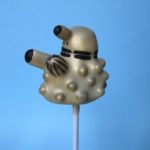I recently discovered that the BBC’s original pitch for Doctor Who is online. The pitch is divided into five documents. Most pitches I’ve seen are single documents which roughly describe a proposed TV show. Because the Doctor Who pitch is five documents, you see the progression of how the BBC went from considering a new science fiction series to creating Doctor Who. As always some of the most interesting portions of the pitch are items which never made it into the series.
The first document in the pitch, Sci-Fi – BBC Report looks at the state of science fiction and its relevance to television.
This document mentions “Quatermass” and “Andromeda” Quatermass was a series of science fiction mini-series: Quatermass Experiment (1953), Quatermass II (1955), & Quatermass and The Pit
(1958/1959). There were other Quatermass mini-series, but they were after 1962. All three mini-series focused on Professor Bernard Quatermass, head of the British Experimental Rocket Group, and his adventures with aliens on Earth.
Andromeda was another series of science fiction mini-series: A is for Andromeda (1961) and The Andromeda Breakthrough (1962). Andromeda was an artificial biological life form.
In this document, both are grouped together as having “the type of plot in which the whole of mankind is threatened, usually from an “alien” source.”
One thing that I found really interesting is that the BBC realized that while science fiction was a small television market in 1962, it would grow in the future. “No doubt future audiences will get the taste and hang of SF as exciting in itself, and an entertaining way of probing speculative ideas,…”
The funniest passage is “…he is obsessed with the Time theme, time—travel, fourth dimensions and so on — and we consider this indigestible stuff for the audience.”
At the end of the last document, the BBC was going to meet with Brian Aldiss, who promises to make some suggestions for further reading. This apparently happens, and the second document, Sci-Fi – Follow-up Report, contains summaries of five science fiction stories that were chosen as suitable for adaptation to television. I chuckled at two of the requirements – “They do not include Bug—Eyed Monsters” and “The central characters are never Tin Robots.”
This report includes a mention of an “ITV series which has included The Yellow Pill, Dumb Martian and Little Lost Robot”. This is referring to the Independent Television series Out of This World, a science fiction anthology series hosted by Boris Karloff which only lasted 14 episodes. It ran from June 24th, 1962 until September 22nd, 1962. The Yellow Pill, Dumb Martian and Little Lost Robot were the first three episodes aired. Little Lost Robot is based on Isaac Asimov’s famous robot story of the same name.
The reference to Z Cars isn’t referring to Nissan’s sport car (which hadn’t been invented in 1962), but to an extremely successful police TV series which was on the air for 16 years.
The most important portion of this report is “we consider that two types of plot are reasonably outstanding, namely those dealing with telepaths, see Three to Conquer in the attached list, and those dealing with time travelling, see Guardians of Time. This latter one is particularly attractive as a series, since individual plots can easily be tackled by a variety of script—writers”
The next document, Concept Notes for New SF Drama is extremely rough sketch of a new science fiction series. Originally the three characters – the handsome young man hero, the handsome well dressed heroine age about 30, and the maturer man, 35 – 40, with some “character” twists were partners in a firm of scientific consultants who specializing in troubleshooting.
“In fact, they have a reputation for tackling problems which no—one else could handle; there is almost a feeling of Sherlock Holmes about this side of their work. Our stories are the more unusual cases which come their way.”
The first time I read this document, I dismissed it because it seemed more like Jonny Quest than Doctor Who. But the more I thought about it, the more I realized how similar this was to Doctor Who.
- Early on, Doctor Who focused on a team of individuals more than a single character.
- The Doctor is a brilliant (but quirky) scientist.
- He tackles “problems which no—one else could handle”.
- Episodes takes place at the scene of the problem. Unlike Star Trek where many episodes took place on the Enterprise, Doctor Who episodes rarely take place inside the TARDIS.
- Even the characters carried over: The “handsome young man hero” became Ian Chesterton, the “handsome well dressed heroine age about 30” became Barbara Wright and the “maturer man, 35 – 40, with some “character” twists” became The Doctor.
The next document, Background Notes on Dr. Who is the first one to mention Doctor Who.
it introduces the five main characters: Bridget, Miss McGovern, Cliff, Dr. Who, and Dr. Who’s Machine.
My favorite quote is the following hilarious description of Doctor Who. “Was it by means of Dr. Who’s machine that Aladdin’s palace sailed through the air? Was Merlin Dr. Who? Was Cinderella’s Godmother Dr. Who’s wife chasing him through time? Jacob Marley was Dr. Who slightly tipsy, but what other tricks did he get up to that Yuletide?”
By far, the most interesting portion are the Two Secrets of Dr. Who.
The Secret of Dr. Who: “In his own day, somewhere in our future, he decided to search for a time or for a society or for a physical condition which is ideal, and having found it, to stay there. He stole the machine and set forth on his quest…One symptom of this is his hatred of scientist, inventors, improvers…He malignantly tries to stop progress (the future) wherever he finds it, while searching for his ideal (the past).”
The Second Secret of Dr. Who: “The authorities of his own (or some other future) time are not concerned merely with the theft of an obsolete machine; they are seriously concerned to prevent his monkeying with time, because his secret intention, when he finds his ideal past, is to destroy or nullify the future.”
The first Doctor Who story, An Unearthy Child, was broadcast in four weekly parts from November 23rd to December 14th, 1963. On December 30th, the BBC produced the fifth and final document, An Audience Research Report.
My favorite line is “It was in the grand style of the old pre—talkie films to see a dear old Police Box being hurtled through space and landing on Mars or somewhere. I almost expected to see a batch of Keystone Cops emerge on to the Martian landscape.”
The BBC holds the copyright and trademark for Doctor Who




